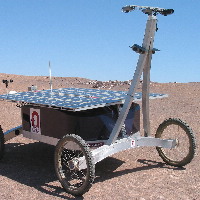Carnegie Mellon University's Hyperion and Zoe

 Need a break from the 6-wheel boggy design? Looking for a Martian rover that offers something new? Then take a look at this month's Popular Science, which poses the question "Is This the Machine That Will Finally Find Life on Mars?"
Need a break from the 6-wheel boggy design? Looking for a Martian rover that offers something new? Then take a look at this month's Popular Science, which poses the question "Is This the Machine That Will Finally Find Life on Mars?"
The machine is the latest from Carnegie Mellon University's David Wettergreen. Zoe is a four wheel-drive, passively steered rover. It grew out of the team's work with Hyperion, which toured the Canadian artic in 2001 and the Atacama Desert in 2003.
Hyperion turns by differentially driving the motors, which flexes the front axel and passively steers. Objects and terrain can also flex the axel, making for a simple reflexive steering. Hyperion has a top speed of 30 cm/second and a turning radius of 2.5 m.
Zoe ups the bar. It has passive steering joints on both the front and rear axels. This added flexibility improves maneuverability. Zoe is also faster than Hyperion, with a top speed of 1.2 m/second.
Both rovers are part of the Life in the Atacama project. They feature sun-synchronous navigation, where the robot adjusts itself and it's navigation to maximize the power from its solar panels, and autonomous control with remote override. Zoe has been fitted out with a spectrometer and fluorescence imager in order to identify and photograph microscopic organisms.
It is an interesting project and has lots of photographs, videos, and papers to explore.
Thanks for helping to keep our community civil!
This post is an advertisement, or vandalism. It is not useful or relevant to the current topic.
You flagged this as spam. Undo flag.Flag Post


